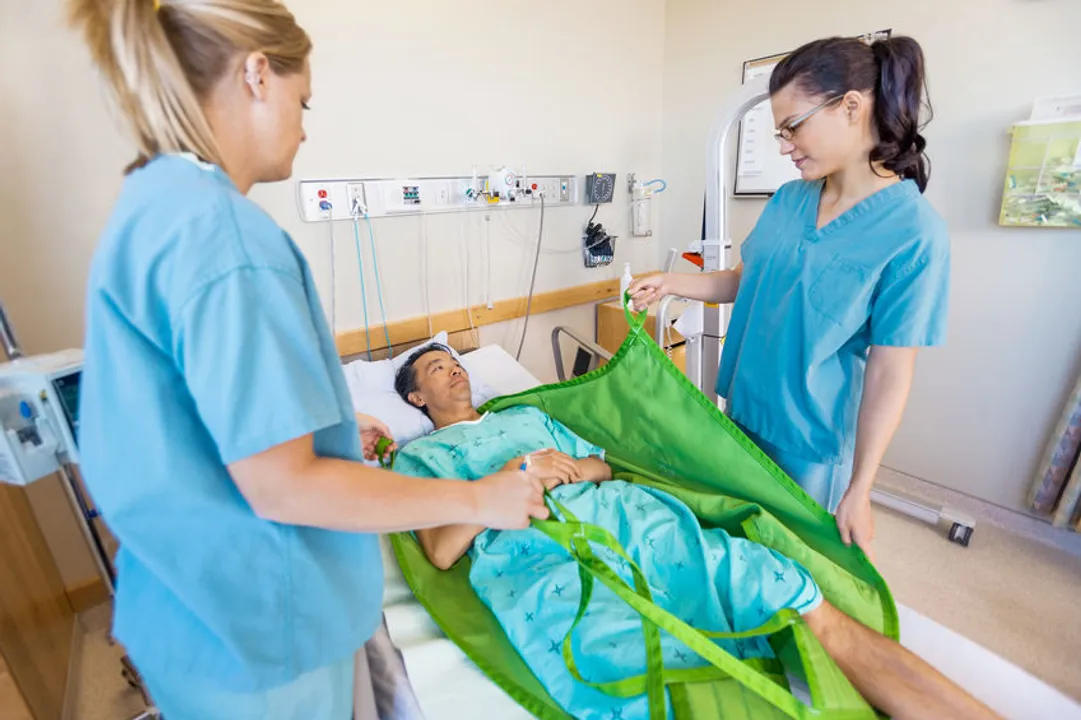How Nurses Can Prevent Injuries and Keep Their Backs Healthy

Tyler Olson/123RF.com
Few things can sideline your nursing career faster than an injury. Nurses that work on the frontlines of patient care in hospitals are especially at risk for injuries. According to the Occupational Health and Safety Administration (OSHA), injuries on the job occur more often at hospitals than construction sites.
Nursing injuries on the job can result from falls, needle sticks, and even assaults. But by far, the most common injury is due to overexertion. According to the United States Department of Labor, Bureau of Labor Statistics, in 2016, 45% of injuries to nurses was due to overexertion.
Common Injuries on the Job
The back is the most frequently injured area of the body for nurses. According to OSHA, strains and sprains are the most common type of injury, especially to the low back.
Overstretching the muscle fibers can lead to a pulled muscle. Repetitive injuries can also occur. Repositioning patients, moving equipment, and being on your feet all day, can take its toll. Repeating these actions multiple times a day, day after day, can lead to chronic problems, such as sciatica pain, bulging discs, and osteoarthritis.
Back injuries at work can have significant consequences. Injuries can lead to spasms, pain, and decreased range of motion. Discomfort can be severe enough that it makes regular movements difficult. In some cases, an injury can lead to extended time off from work. If you can work, chronic pain can have a negative effect on your job performance and morale.
Why Work Injuries Occur in Nursing
Work injuries can happen for several reasons. Some factors that contribute to workplace injuries are patient-related. For example, the obesity rate has increased in the United States, which means nurses may be caring for more patients that are larger.
Patient workloads have also increased in some hospitals. Increased workloads might cause nurses to neglect practices that are time-consuming. For example, instead of getting the proper lift equipment to move a patient, a nurse might manually move the patient because it is quicker.
Trying to lift or reposition a patient on your own can also lead to injuries, but even if you get help lifting, it sometimes is not enough. Lifting with helpers does take some of the weight off of you, but the weight is not distributed equally, which is still not ideal.
Preventing Work Injuries
As a nurse, you are used to taking care of others, but it’s essential to also take care of yourself to avoid injuries at work. Fortunately, there are several things you can do decrease your risk of work injuries, including:
Using proper body mechanics: While it’s ideal to use the right equipment when transferring or lifting a patient, it’s sometimes unavoidable to move a patient without a lift. Make sure you raise the bed to a comfortable position, lift close to your midsection, and avoid bending at your back. Maintaining the spine in a neutral position when bending involves hinging forward to keep the back straight.
Getting help: If you need to move a patient, get the help of a second staff person. It might take an extra minute to locate someone, but if it is not a life-threatening situation, it’s worth taking a little extra time to keep yourself safe from injury.
Utilizing the lift team: Many hospitals have a lift team in place to assist with patient care. The lift team is trained to move and transfer patients. When possible, use the lift team at your facility.
Maintaining an ergonomically correct workstation: Whether you’re charting, putting in orders, or reviewing medical histories, nurses spend a reasonable amount of time in front of the computer. Make sure your workstation is set up correctly. Sit up to keep your spine straight. Your knees should be at hip level when sitting. Your computer monitor should be at eye levels to prevent neck strain.
Using the correct equipment: Your best bet to avoid injuries is to use lift equipment provided by your facility. Even small hospitals usually have patient lifts, such as motorized ceiling lifts, portable lifts, and sit-to-stand lifts. Although designs may vary by manufacturer, lifts are designed for transferring patients from one place to another, such as from the bed to the chair.
Keeping your back healthy: A strong, healthy back is less likely to become injured. Exercising regularly not only strengthens your back, but it also helps you maintain a healthy weight. Being overweight places more strain on your back. Also, see your doctor for routine checkups to detect problems before they become more serious.
Although caring for your patients is usually your first thought, don’t neglect your own well-being. Injuries will not only interfere with your career, but an injury can also adversely affect your entire life. Take precautions and be diligent about protecting yourself from injuries. Remember, taking care of yourself helps you to be there for your patients.
Nursing Jobs available at HospitalRecruiting.com
- Registered Nurse Jobs: https://www.hospitalrecruiting.com/jobs/RN-Jobs/
- Nurse Practitioner Jobs: https://www.hospitalrecruiting.com/jobs/Nurse-Practitioner-Jobs/
- CRNA Jobs: https://www.hospitalrecruiting.com/jobs/CRNA-Jobs/
- Nursing Assistant Jobs: https://www.hospitalrecruiting.com/jobs/Nursing-Assistant-Jobs/
- LPN Jobs: https://www.hospitalrecruiting.com/jobs/LPN-Jobs/
Related Posts
